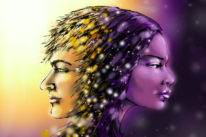
“When I look back on my life, I see pain, mistakes, and heartache. When I look in the mirror, I see strength, learned lessons, and pride in myself.” ~Unknown
Years ago, I wrote in my journal: “My life has no meaning. I’m sick of being miserable, of struggling and having to prop myself up. I’m tired of being alone, tired of feeling like I’m wasting my life, tired of feeling like a loser.”
I was that friend who always borrowed money, who was always in crisis or calling at 2 a.m. and saying dramatically, “I’m not okay.”
There are few pieces of self-knowledge worse than being aware of exhausting people or driving them away with neediness.
In 2010, I decided I would try to rewire my wildly anxious brain for inner peace. As I look back on how much has changed (everything!), the throughline of my journey has been “developing self-awareness.” The more I develop awareness about how this mind and body work, the more empowered and peaceful I feel.
Here are some of the key lessons I learned on the path to inner peace.
1. Fill your own cup first.
I grew in a culture where the social contract went something like this: “I’ll perform social niceties to protect you from uncomfortable feelings, and you’ll do the same.” (I was really not good at this.)
Nobody told the truth about how they were feeling or what they needed, and in turn, that made true communication or connection impossible. As an adult, therefore, I turned to other people for my emotional well-being, when the truth was that the only solution lay inside me.
One day, when I was on a bus to a freelance job in downtown Vancouver, I received a voicemail that I’d been let go and that my last check would be mailed to me. I’d been counting on that check; I didn’t have the $20 I needed to get home on the ferry. In a panic, I called a former colleague, who met me at Starbucks and, though she was visibly annoyed, lent me the money to get home.
On my way home, I had an epiphany: I could offer to myself the focus and energy I’d been so eagerly forcing on others. In the clunky vocabulary of my growth at that time, I called it my “me first” project.
I began meditating and, as I inhaled, I called different parts of my soul back to me, kind of like ‘defragmenting’ a Windows PC. To my surprise, not only did I begin to feel whole for the first time, I also felt calmer and more confident about my resilience.
If our well-being depends on someone else being comfortable, we will never feel peaceful. We have zero control over how anyone else feels, thinks, or behaves. There are infinite factors that go into each person’s mood, and each of us is responsible, ultimately, for our own well-being.
That doesn’t mean we can’t work to change systems of oppression, but if we’re relying on conditions being the way we want in order to feel peaceful… we could be waiting a long, long time.
2. Stay on the razor’s edge of this moment.
I used to call myself a “Walter Mitty,” in reference to the James Thurber short story (and Ben Stiller movie) about a man who constantly fantasized about living different lives than the one he had, like being an emergency room surgeon or a fighter pilot.
“I want to be mindful,” I wrote in my journal, “but my mind runs all over.” I hadn’t yet understood that mindfulness doesn’t just happen; I had to put in the work.
That’s what the brain does, though. It thinks. It ruminates. It creates stories. My mind still runs away with me sometimes, but over the process of more than a decade, I’ve become accustomed to its machinations, and it can no longer devastate me with thoughts of self-loathing.
Presence is about accepting the facts of a situation, not our interpretation of the facts. I find it particularly helpful to remember this when thoughts are swirling through my head like a tornado, or I have sensations associated with anxiety, like a racing heart or tight chest.
To bring myself back into the moment, I notice external sensations: In this moment, there is air against my arms. In this moment, I can feel my feet on the ground. In this moment, I smell a mixture of food grease and roses.
I don’t label any of this “good” or “bad”; it just is. Focusing on reality, rather than thoughts, interrupts the pattern of rumination in the mind.
One of my favorite presence practices comes from Eckhart Tolle: Close your eyes and rub your hands together briskly for fifteen seconds. Then separate your hands and focus all your energy on the vibration in your hands. If thoughts arise, redirect the mind back to the sensations in your hands.
This takes mental energy away from loops of rumination and places it back in the body, which—unlike the mind—is always present.
3. Learn to observe your thoughts.
The difference between my self-loathing rumination of the past and my present sense of peace when my mind is a runaway horse comes down to practice in observing my thoughts. Most of us think constantly, and we’re not aware that we’re thinking. Thoughts enter and leave our minds continually, but we have to pay attention to those thoughts in order to understand that thoughts are not who we are, and thereby find peace.
Thinking is like breathing. Sometimes we think in order to solve a particular problem. Other times, thoughts just appear and disappear like signals on a car radio in the mountains. We don’t purposely generate those thoughts; they just appear.
As I learned to meditate, I became used to seeing thoughts floating in and out of my mind. I learned that they don’t last unless I put some effort into keeping them around, like thinking, “This shouldn’t be happening” or “I don’t like this situation.” Neither of those are helpful, as the situation—whatever it is—is happening.
Then I tried watching my thoughts in real-time, off the cushion. It took me several months to begin noticing my thoughts. At first, I walked around with my head tilted, like a dog trying to figure out where a sound is coming from. I was determined to catch myself in the act of thinking, but because I’d spent forty-four years thinking nonstop without being aware of it, this took a great deal of practice.
Sometimes I’d feel terrible, and I’d put on my investigative cap to discover what thought was causing the distress. Other times, I’d be thinking for half an hour before I’d suddenly snap out of it and go, “Aha! I’m thinking!”
It was such a revelation to understand that I am not my thoughts. Thoughts arise within this field of mind and body I call “me,” but they are not part and parcel of this being. Being trapped believing thoughts is a special kind of hell; when we understand that those thoughts aren’t who we are, it creates a space in which we can begin to breathe and to climb out of hell.
4. Separate facts from stories.
I’ve been a creative writer for more than thirty years. I’ve always enjoyed writing humor, because humor requires placing a judgment on a situation. I wrote essays and comedy sketches (and even did stand-up briefly) about how awful or hilarious or terrible a given situation was.
Long ago, when a beloved therapist was diagnosed with a recurrence of melanoma and closed her practice, I laugh-cried that …And My Therapist Has Cancer would make a great book title. I felt terrible for her, of course, but not as bad as I felt for myself, losing one of the best therapists I’d ever had. OF COURSE this had happened to me.
Except that it hadn’t. I could have chosen to focus on gratitude for my own health, or for what this woman had already given me. I could have seen this as impermanence, and let go with grace. But I didn’t have those skills yet.
When I became serious about finding inner peace, I stopped writing humor and essays for several years. At some level, I understood that repeating those stories—each one designed to be witty but also to make me the righteous victim—continued to wire my brain for feeling bad.
Marshall Rosenberg’s book Nonviolent Communication: A Language of Life talks about separating facts from our interpretations of the facts. For months on end, I noticed my responses to different situations based on the stories I was telling myself. Then I’d pull back and practice listing “the facts in evidence.” These often had little to do with the stories I’d created.
Making judgments is so automatic, like thinking or breathing, that we don’t even notice we’re doing it.
I began to develop a vocabulary of my feelings and needs. Having lived so long from the neck up, I had to learn how to identify my emotions, and to understand which needs were giving rise to which feelings.
Every human on the planet has the same basic needs: to be safe, to be healthy, to be autonomous and loved (among others). When those needs are met, generally speaking, we feel good or at least peaceful. When those needs aren’t met, we might feel anger, anxiety, depression, or resentment. Learning to identify our feelings and needs in each moment is a huge step toward self-awareness and inner peace.
Ultimately, this comes down to taking full responsibility.
We have to take responsibility for our own well-being because no one else can heal for us. We can’t control people, situations, or events. Heck, we can’t even control our own thoughts or feelings! But we can examine our thoughts and feelings, be more deliberate with our actions, and practice awareness.
Rather than asking the universe to help us like a lost child, we can realize that we are part of the universe—we’re made of the same chemical compounds; we share DNA with all living things—and we will contribute to our own healing.
This is important so that we don’t project trauma responses from our childhoods onto others, and we don’t repeat old patterns or contribute to systems of oppression. Developing self-awareness is taking radical responsibility for our own well-being, because if our inner peace depends on what others say or do, or certain conditions, we’ll never find it.
Self-awareness is a necessary skill for finding inner peace and living from our wiser nature, yet it’s a skill that isn’t taught in schools or even in most families. That means that it’s on us to cultivate it in ourselves.
About Sarah Chauncey
Sarah Chauncey is a veteran writer, freelance developmental editor, and the author of the pet-loss gift book P.S. I Love You More Than Tuna. After a spontaneous awakening in 2010, she spent seven years mostly in silence and solitude, listening to life and taking notes. Those notes became the Substack The Counterintuitive Guide to Life, which helps readers find inner peace by developing self-awareness and skillfully navigating life’s paradoxes. She also writes Resonant Storytelling, a newsletter for writers.













 Though I run this site, it is not mine. It's ours. It's not about me. It's about us. Your stories and your wisdom are just as meaningful as mine.
Though I run this site, it is not mine. It's ours. It's not about me. It's about us. Your stories and your wisdom are just as meaningful as mine. 